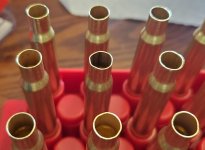I have and have not...just bought 50 new Hornady 300 Savage cases for a 99. I have loaded this same new brass for this rifle in the past without resizing with no problems.
Sometimes I don't size NEW brass for other calibers and I have never had a problem, but I'm talking bottlenecked rifle cases. I do inspect the case, especially necks before loading.
My reasoning is that if Hornady, etc. is going to load new ammo, are they going to run their new brass through a sizer again before loading? I doubt it, although they might have some other quality control method.
Why waste time and work the brass if it's not really necessary ?
Sometimes I don't size NEW brass for other calibers and I have never had a problem, but I'm talking bottlenecked rifle cases. I do inspect the case, especially necks before loading.
My reasoning is that if Hornady, etc. is going to load new ammo, are they going to run their new brass through a sizer again before loading? I doubt it, although they might have some other quality control method.
Why waste time and work the brass if it's not really necessary ?

